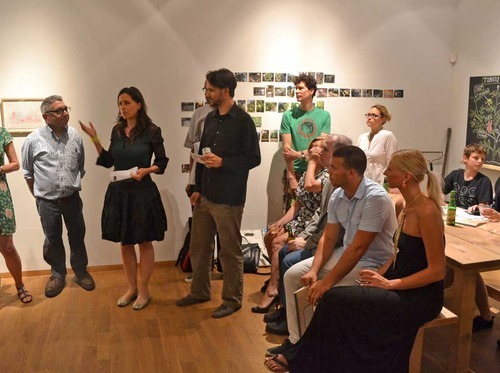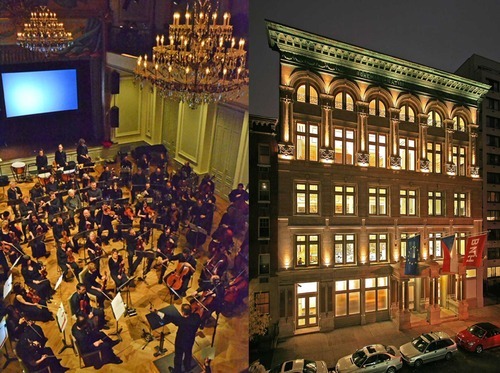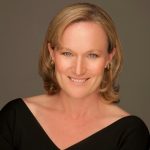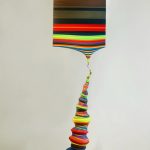Con Edison Immigrant Artist Program Newsletter, Issue No. 57
Interview: Kristyna and Marek Milde from the Czech Center New York (CCNY)
This month, IAP highlights the comprehensive and prolific activities of the Czech Center New York, interviewing Program Manager Kristyna Milde and Production Manager Marek Milde, who also collaborate as part of their artistic practice. In light of an upcoming exhibition at Wave Hill’s Sunroom Project Space, opening on May 23, we took the opportunity to learn more about both the CCNY and Kristyna’s and Marek’s collaborative process, with a focus on how each influences and interacts with the other.
Can you tell us about the mission and activities of The Czech Center New York?
The Czech Center New York (CCNY) is the official cultural institute of the Czech Republic, dedicated to promoting Czech art abroad and fostering interaction between Czechs, Americans, and the wide international community in New York City. The CCNY, established in 1995, is part of an international network of Czech Centers supporting artists, professionals, and cultural exchange in 23 countries on three continents. CCNY is located in the recently redesigned Bohemian National Hall (BNH) on the Upper East Side, on E. 73rd Street between First and Second Avenues, which is a five-story building, built in 1896. It is a rare survivor of the many social halls built in the nineteenth century for New York City’s immigrant ethnic communities. Our facilities include a gallery, cinema, performance hall seating 300 people, and a rooftop terrace.
Our team of four people creates programs of about 80–100 events per year. We host a wide range of mostly free events showcasing contemporary Czech art, together with international collaborations in music, fine art, and design, and feature annual film festivals and seasonal rooftop screenings.
We focus on presenting contemporary artists and projects, which are committed to engaging cultural discourse and addressing relevant cultural- and social themes. While we provide a platform for interaction and dialogue of Czechs with local and international artists, we encourage production of new works and are presenting concerts, screenings that are North American- or world premieres, and site-specific installations in our gallery.
While primarily supporting Czech culture, the organization is also open to ideas around current cultural or social themes and international projects. Can you point to recent examples of this?
While Czech Center New York’s mission is to Czech culture, it seems that in the interconnected world of today, the cultural presentation based solely on the national origin is fading. We think the art today, rather than present itself, needs to communicate and be aware of the international discourse. We are pleased that in the recent past, we have be able to organize series of international collaborations in which the Czech was not just the label of the country of origin, but rather an element of driving cultural force.
CCNY is a member of European Union National Institutes for Culture (EUNIC), which includes European Cultural Institutes in New York, and representatives from the cultural departments of European Consulates and Embassies in NYC. We collaborate on events and festivals throughout the year. For example, the European Film Festival, which the Czech Center established 6 years ago, grew from a small collaboration of a few countries to a large 2 week festival with about 20 participants now called Panorama Europe. This year we partnered with the Museum of the Moving Image to enable the festival’s expansion.
Another recent example is an art criticism conference, which we organized together with Finnish, Polish, and Spanish cultural institutes and AICA International on April 27, called “Walking in the Air: Art Criticism in Europe.” We had five speakers talking about the current state of art criticism in their representative countries, and Hrag Vartanian as a moderator, who is the editor and co-founder of the influential arts blog Hyperallergic. We are hoping to establish this conference as an annual event as well.
Coming up at CCNY on May 27 at 7:00 PM is the US release of Mariusz Szczygieł’s newly published book, Gottland, translated to English, that deals with the Czech history from the Polish perspective and world premiere for a Czech film based on the same book. The event will include excepts from the film and is a collaboration with the Polish Cultural Institute and Melville House, the local publisher.
Last year, Marek and I co-curated exhibition project Poison Green at the Czech Center that presented Czech and American environmental artists that also included a temporary community garden called Dinner Garden on the rooftop of the Bohemian National Hall. We invited a group of locals to test their ability to grow food just enough for a single dish. The gardening project currently continues in a charter school in Bed-Stuy, serving as a model for Brooklyn children. For the growing season in 2014, we are preparing a new project for the Old Fulton Plaza in Dumbo called À la cart, organized as part of the upcoming exhibition FOODshed at the Smack Mellon Gallery, opening June 7. The piece will consist of a fleet of shopping carts filled with soil, serving as pots for plants and vegetables that will be grown according to a menu produced by the local participants. À la cart strives to bring awareness to the process of food production, by facilitating the experience of growing food instead of buying it.

What bought you both to the US? Since moving here, what has struck you about your experience so far? How have you navigated the contemporary art world?
We first visited New York in 2000 and immediately fell in love with the city and its empowering atmosphere. The dynamic and creativity accumulated by people from all over the world was very inspiring. While we both originally come from Prague, Czech Republic, at that time we had lived and studied in Switzerland and Germany for seven years but kept returning to the New York to explore the vibrant local art community. In 2003, we decided to come here to earn our MFAs. New York City became our home rather gradually: the transition took time and quite a lot of energy, revealing the downsides and struggles of its daily reality. However, the perpetual active spirit of making, shared by the local community, was encouraging. It seems that in the air is an unpretentious excitement to Do Stuff — to make things possible that may not work out elsewhere. The move was a valuable experience that shifted our perception of what and how we would like to do in our art practice. It evolved from what can be described a formal expression to a more conceptual one, socially and environmentally engaged.
Collaboration features prominently in both your working lives at the Czech Center New York and your own artistic practice. Can you describe how you work together as artists and as arts administrators? Does one role inform the other? Do you have any advice to offer as to what makes a successful collaboration?
As you mentioned: as artists we are working collaboratively, but we are also colleagues at the Czech Center. That means that we are sharing quite a lot of our daily routine as partners, artists, and art administrators. Our daily job is quite demanding and time-consuming. So as we both started to work full-time, we were not sure how far we would be able to keep our practice and still have a studio time. We realized however, that any spare moment be used productively for discussions, brain-storming ideas, or looking for found materials, which we can utilize in our art. Consequently our art practice/studio time is less solitary: It is constantly developing and shifting, reflecting our daily surrounding. Our work at the Czech Center also helped us to be more organized and goal-oriented, and to handle the related tasks of our art practice in a more effective and professional manner. On the other hand, for the institutional part, the artistic background and sensitivity helps us to better communicate with the artists, to be more empathetic in terms of their needs and creative process.
The collaboration is central to our daily work and in our art practice since we think that four eyes see more than two. However, though coming to an agreement on a certain vision can be challenging, the outcome of the double perspective is more complex and fruitful, and totally worth the efforts. It is hard to give one recipe for a successful collaboration; we are learning all the time. Usually when all participants feel like they have contributed their best and there is a sense of equality in the involvement, it is a win-win situation for everybody. Probably most important is sharing the common excitement in the topic and the sense of humor.

You are currently installing your project, Hills and Valleys of the Sofa Wilderness, at Wave Hill’s Sunroom Project Space. Can you talk about your inspiration for the project, and how you envision the audience interacting with the site-specific installation?
For our show at Wave Hill we created a lounge environment, where visitors can experience the natural landscape from the comfort of the domestic interior. The piece, titled Hills and Valleys of the Sofa Wilderness is a transfer of a site from the woods of Manitoga in Garrison, NY. A relief of woodland floor is utilized in containers shaped as a couch and chair filled with transplanted ferns, moss, grasses and stones. We encourage visitors to sit down, as they would in the forest, and experience the forms, texture, smell and feeling of the organic materials. The piece recalls our experience from a trip to the wilderness in the White Mountains, NH, where on a weeklong hike we realized the differences in the interaction with the environment in nature and domesticity. While in the forest one can move and sit or perhaps spill a coffee almost anywhere, in the constructed indoor environments, the bodily spatial interaction is narrowed to furniture and strictly limited by cultural codes. We believe that the comforts of our homes are double-sided. On one hand, they are providing the ease of sitting, lying, and resting, but on the other also depriving our basic spatial experience. They predetermine and dictate the way we physically relate to our closest surroundings ultimately producing a removed perspective of the world. Chances are that one can get wet by sitting down on our piece a potentially get smeared by dirt or get couple of pine needles on the cloth. What can be seen as disturbance, we consider a productive part of the experience; provoking questions of our basic relations with the natural world.
While deconstructing the traditional use of plant motifs in interior design, Hills and Valleys addresses the limits of the interior-based culture, creating a model that engages active experiencing in the face of being trapped in the comfortable cushioning of domesticity.
You can experience Hills and Valleys of the Sofa Wilderness, curated by Gabriel Guzman, at Wave Hill’s Sunroom Project Space from May 23–July 6, 2014. On June 22 at 1:30 PM, you can “Meet the Artists.” For more information, click here.
To sign up to hear about upcoming events at The Czech Center, click here.





